Posts in Category: woodwork
A much improved carving attempt
Tonight was a good carving night. I wanted to try the carving pattern on the 17th century box again, to see if I could improve my carving. Normally these boxes are only carved on the front face of the box, but I am going to carve both sides just to get the practice. I can tell that the practice helped from side one to side two, as my second attempt was so much better.
I learned a few tricks the first time I was able to apply the second time, and I came up with a couple new ideas and tools. I also re-watched the Peter Follansbee carving video again. I also had a better feel for the spacing of the “fans”, and found an old nail punch in a drawer that made a nice dot for the decoration.
As requested on the last post I took a lot more pictures along the line.
Here is the source of the design inspiration again. I keep a print out of it on my workbench to keep referring to, and looking at the carving over and over again.
Carving layout trick
Tonight I started work on another version of the carving layout from last time. I was setting up to measure out the layout, and happened on a method of laying out perfect squares with no measuring. The 17th century layout that I’m using, is based on squares, and my first attempt was a little off because my measuring wasn’t perfect. This trick worked great, and my squares were right on.
Here is the finished layout, with the tools I used to accomplish this.
Steps:
1. Using a marking gauge, layout a border along the top and bottom of the board along the long edge.
2. Using the compass starting at one end along one of the edge lines, figure out the middle point. I just keep switching back and forth between the ends moving it a little each time until the arms of the compass are at the same point from both ends.
3. Using a square draw a line down the mid point line across both edge lines.
4. Put your compass in the point where the mid point and top edge line meet, and spread the arms to the opposite point on the bottom.
5. Make an arc lightly on both sides, and repeat from the bottom point.
6. The point where the two arcs cross is the middle length line, and you can mark this line with a straight edge through both points.
7. Now put the compass arms to the top mid point, and the point where the middle lines meet. This is the size of your squares.
8. Pace out points along the top line, using the width you found in step seven, and mark lines from each of these points with the square again.
Ta Da! You have a square layout, no measuring, and you didn’t have to do any complicated math to figure out the size of the squares. Now it does help to measure out some rough idea of what you want to make sure you cut the wood to the right size, but I leave a little on each end to trim down later.
The first time I tried doing the squares, I spent a lot of time trying to find the right size for the squares, dividing and fudging, and in the end my measurements were off a little bit. This way I can make it close enough in length, and just pace out the squares based on initial measurement (the top and bottom edge setting on the marking gauge).
My first 17th century carving attempt
The last month or so has been a whirlwind of stress at work, as well as being very cold in the shop so I haven’t been able to get down there as much as I wanted. But finally I got a little time to work on this carving that I wanted to work on since I got my Peter Follansbee set of carving chisels. I’d been admiring this particular pattern on a 17th century box he’d posted in his blog a few times, and I thought it might be a good place to start working from. The reason I chose it to start was because it was mostly V tool work, and I could visualize almost every step in my head. Plus it looks very cool, which is always a plus. I’m going to be making a bible box in the near future as a present, and this was one thought for the carving I wanted to add to the box. So, I cut up some flatsawn Oak stock and gave it a whirl, and it came out pretty good for my first attempt really even if I can’t get any riven partially green stock like PF uses.
To achieve this carving, I started with a simple grid layout of 3″ squares centered on the front. I did multiple sketches on paper first to work out the details, and this was the easiest way to start the layout process. Once I had the grid lightly marked into the wood, I got out the compass and made a series of arcs along the top and bottom rows, alternating the starting points to get them offset. I made one big mistake here, and didn’t count out the grid exactly right and as such, my design was short one set of arcs/grid squares, but it works out because the design looks good on any number of repeats.
Once I had my first set of arcs down (I penciled them in above to make them clearer in the photo) I eyeballed a good looking distance and carved another set of arcs inside the first set of arcs.  This could have been a little bigger I think, but overall it didn’t look too bad to my eye.
And that was the extent of the actual layout for this design.  I did most of the rest of the design freehand with what looked good, trying to follow with traditional carving techniques as I’ve learned of then in PF’s blog. He shows numerous examples of symmetry being off for our modern eyes and numerous things we would call “mistakes”. Once you look at it as a whole though, it all looks good. The major mistakes I made doing this were the bottom U shaped cuts, I need to actually lay those out next time, as going from either side was difficult to reproduce, and my half moons in the lower arc were chipping out a lot which could be wood, or technique issues.
But overall, for a first practice piece I felt pretty good about it, and it was good to finally get to practice what I’d been reading about on PF’s Blog, and watching his DVD.
Badger
How to cut a dado using hand tools.
Cutting a dado
When I set out to the dado for the train rack project, I sat down with the internet and browsed a few books. It took longer than I wanted to find a method using no power tools. Cutting a dado slot is most frequently done by table saw if you believed the internet. I didn’t want to use my table saw, besides, I don’t have a stacked set of a dado blades either. I finally found what I was looking for in the Tomes of Saint Roy, and I set out to do this my self. It turned out to be as easy as he said it would be. And I was able to get a nice crisp line slot cut quickly without having to use my noisy, and to be honest a little scary, table saw. Here is how I cut my first dado slots by hand.
Marking the Board
The first step is to mark all the important lines you’ll need to make your dados clean and even. Take a marking gauge and mark the long side with the depth the dados should be. Then take your take your square and mark out the lines where the dado’s will go. Plan this part carefully, and take your time laying the lines out and will show in the final work.
It really helps to have your work secure as you start this, but it could be done on a bench hook if you don’t have an end vise and bench dogs set up. Once you have your line drawn in a light pencil mark, take a marking knife to follow that line with a shallow cut. It helps to hold the square firmly, and keep the knife pressed against the edge of the square, and the handle straight up and down from the board. First pass should be a light cut, focused on keeping it straight and true. Subsequent cuts should follow this line, going deeper each pass until you have a nice deep cut. The goal is to sever the fibers, and make a square straight line with a clean edge. If you just cut straight on the pencil line with a saw you’ll likely end up with frayed or rough edges. Now is a good time to mark the waste side as well, just like in dovetailing, so you can keep your cuts on the correct side of the line.
Cutting the V
Once you’ve got a good cut line in the board, you take your knife and cut a sort of V groove on waste side of the line.  Make sure to not undercut your straight side, and keep the cuts in the waste side of the line. It doesn’t have to be super straight, since you’ll be getting rid of this material anyway. You’re going to create a trough for the saw to ride in, which will make your cut go straight and keep it riding where you want it to. It’s too easy for a saw to skip when you’re starting your first cut which can lead to ugly edges where it might show on your finished piece. I also find it helpful to cut an extra notch with my knife where the saw cut would start to prevent any chance of skipping, just make sure to only notch the waste side, otherwise it will show.
Sawing the line
Now that we have a trough for the saw to ride in, it’s time to cut the line down to our marked depth. I’m using a vintage Disston back saw that I picked up at an antique store and rehabbed for this, but any clean cutting saw should do as long as the kerf isn’t too wide. Take the saw and rest it in your groove, and carefully start your cut. Keep an eye on the cut and make sure it’s on track and it’s not jumping around scarring the work. Once you have a good cut going, you can pick up the pace a little, just keep good control in mind. Check frequently on both sides to make sure you are not cutting below your marked depth. It doesn’t take long to get to the depth usually, since the dado is probably not too deep. Make sure you’re right up to the depth line on both sides, and stop.
Make the second cut
Now we should be ready to cut the second line, but first it’s a good idea to double check your width by holding your shelf board to the line, and seeing if you need to adjust it any. I had been sloppy in marking my lines the first time, so you can see second pencil line in the photo. Sizing from the actual board is a good way to eliminate any measuring mistakes. Repeat the steps for cutting the first line with the marking knife, but be this time be sure to cut your V on the other side of the line, keeping it in the waste as always. After cutting a good V, saw down to the line as before.
Chisel out the waste
Now it’s time to start making the actual dado after all that measuring, marking and and cutting. Take a chisel as close to the width of your dado as possible, or smaller if you don’t have close, and begin to chisel out the waste. I like to start on each side with a quick tap a third to half way from the top to prevent tear out. Don’t try and hog the whole thing out at once, just take a couple layers out first. Go easy for the first third to create the walls, and then you can be a little more aggressive. Once you’re into it, I liked laying it bevel up and holding it flat and pushing it horizontally to peel up the bulk of the waste, but use whatever chisel technique you’re comfortable with. If you’re going to use a router plane to finish, then don’t go all the way to the bottom of you cut, leave it a little proud. Otherwise, pare down the wood as smooth as you can.
Finish the bottom of the cut
I used a Stanley #71 to finish out the dado bottom to ensure a clean tight fit. I set the depth at just shy of the marked line for the first couple of passes to avoid tearing out too much, but it went really quickly and I had a nice clean trough in no time. A final pass at the marked depth, and I was done and had a clean edged dado.
Final Thoughts
This took a lot less time than I thought it would, and once I had the technique down (and took lots of photos) on the first board, I was able to assembly line the second board in half the time. The project was well recieved by my “client” aka my 3 year old son, who got a sweet new rack for his growing Thomas Train collection.
Jewelry Box
Unfortunately I have to go back to work tomorrow. :(Â But before I go, I wanted to finish a project up before I lost all my time again to my day job.
I started on this project a couple of days ago, and was able to finish it fairly quickly. This is quite a bit quicker than I expected, even though the box is a simple design. I used my new dovetail and it was a dream to use. Comfortable, smooth and very effective, I highly recommend it.
The box is 1/2″ Poplar from the Home Depot, dovetailed on all four sides, and finished with two coats Bulls Eye Amber Shellac (another first for me.) The top and bottom are rebated to set into the body with the bottom glued in, and the top just resting. Funny story about the design though, I had all four sides dovetailed, and thought I was doing great until I realized that the wide board that I had bought with the side material was not as wide as I thought it was. I had to change my plans all together, and came up with this design. It works out pretty well, gives the box a floating appearance.
The shellac was super easy to use, I was surprised. I’ve been dreading learning finishing, but this went on easy (I could use work on my application for sure) and dried quickly enough to do two coats in one night. I’m going to use this stuff again for sure, I might try thinning it the first coat though, and getting a better brush like I’ve seen suggested.
The wife was very pleased, to see such immediate return on the gift of the saw, and I’m pleased with how it turned out. Too bad I have to go back to work.
Badger
Chopping some mortise
Tonight I achieved another first, in a long line of firsts. My first mortises, in my own shop. I chopped a single mortise when I attended the woodworking course at Roy Underhill’s Woodwright School but that was under controlled circumstances, and under the watchful eye of Roy himself. These are not very pretty, but they are mine all mine.
These are for my Frankenbench that I am building when I can. The legs are scavenged from a bed frame that I have been holding onto. One pair of the legs had really ugly mortises (uglier than mine, can you believe it?) that I will be able to re-use. The other pair of legs came from the head of the bed, and didn’t have the same mortises. So, I grabbed my gauge, marked it up and started drilling out the waste. It felt good to be able to do something simple like that without having to fake a tool or wonder if I was doing it right. I knew enough about this operation either through reading books or online, or having seen it on Roy’s show. Plus I got to use the big hammer for it’s intended purpose, thumping a chisel into wood. I still need to cut some of the side railing from this bed frame into some short stretchers to fit the mortise, and glue up the leg pairs and fit them to the top. I’ll admit to being a little nervous about this part, so I’m going slowly.
The bench top (a riff on a Nicholson top) is upside down on some sawhorses I got at IKEA.  Scoff not! I actually like these things a lot. We got them on sale a couple years ago intending to build an adjustable height work area for my wife to use in her sewing room. We never did get around to building that out like we wanted because my son came along and distracted us quite a bit from everything. They do that, I understand this now, but wouldn’t trade it for the world. Once I’m done with the workbench they might actually go into service in the sewing room as a desk, but that’s a project for spring I think.
I fit the end vise and drilled the holes for it. I just need to drill some counter sinks for the bolts into the top and I should be able to bolt it on. All in all I made some really good progress after being stalled for so long. If I can get this build and solid, I can start working on actual projects theoretically. And I will be getting some well deserved time off from work for the holidays, which is mostly eaten up by birthdays (3) and family gatherings for the family (2), but I will be able to get a few days here and there to work.
Also tomorrow I found another painting that actually solved a little mystery on one of the planes I discovered a while back in 1574 painting. More to come on that.
Badger
A couple of keychains
I haven’t done any pen-kit style turning in a while, but I’ve been meaning to make these kits for a while. I got a handful of these on sale a while back and never got around to making them. I decided to make a present for my wife this afternoon, and turned these little guys out of the mystery wood offcuts from my saw handle. There is some really nice curl in the section I cut off, and I wanted to show it off. I finished them with my standard mix of Walnut Oil, and alternating coats of oil and superglue.
These key rings have a little bit of a secret. They look like standard key fobs, but the top screws off to reveal a small tube inside. Not very useful unless you want to have toothpicks with you always. I’m going to use mine to keep a couple of pills in, for just in case I forget in the morning before heading to work. The older you get, the more pills you have to take it seems. I’ve got one that I need take daily, and sometimes I miss it rushing to the bus. My stomach will not be happy with me if I skip it, so I thought I’ll keep a spare on me for rushed mornings.
Badger
Close up shots of the new Backsaw handle.
So, now that the oil finish had dried, I got a couple good close up shots of the handle from the last post. I realized that none of the shots really showed the wood (blame the lighting in there, terrible for photography).
Still not sure what the wood is, it was old and dusty from a pile that I salvaged. It has some really nice warm tones that Walnut doesn’t typically have, so it might Koa or some other tropical species. It does have some nice color to it though.
badger
Making a new backsaw handle
When I was working down in the garage last week I noticed that my Disston backsaw handle had cracked even further. I picked it up at a antique store a while back, rusty and beaten down (but not out). I had revived the blade, and it has become a staple in the shop for mid level sawing. Tonight I made a new handle for this saw, my bench top workhorse of a saw. In three hours no less!
Christopher Schwarz might say Medium in the Coarse Medium and Fine scale, at least I think that’s what it implies as I’ve not picked up the book yet. It’s a concept I get though once I thought about, grouping tools into ones that handle the coarse, the medium and the fine.
Anyway, I got a little time tonight to work in the shop and rather than work on the project I had started last week, I decided to pick up a new project. When I get time, I tend to go with the flow, almost Zenlike if you will, although I think Zen might require less swearing and dropped tools. I picked up the backsaw to move it out of my way, and noticed the handle split again.
I picked up a random piece of scrap wood I had salvaged from the 2nd Use store, Walnut I think, and traced my old handle on the board. I sketched the busted off bottom horn by putting on of my Disston handsaws down, and making it fit. Then I tweaked it a little to make the whole think look right.
To make the cut outs and make the inner curves I tried a trick I read on a blog somewhere, and used a number 12 and number 16 auger bit to make the really tight curves of the inner handle and under the horns in the back of the handle. I cranked these up in my brace and bit (is it just a brace?) and did one side till the lead screw poked out the other side, and then flipped it over to get a clean hole with no tear out.
Then I cut out whole thing using a coping saw mostly with some straight cuts with my crosscut or dovetail saw. (Coarse and Fine, but really it was whatever worked and was handy.) I tried to stay as close to my pencil lines as I could. The auger holes were a HUGE help and really made this much easier. I highly recommend this approach when making a saw handle like this.
Then it was time for lots of file work. This is what took most of the three hours, mostly with a coarse toothed rasp that had a round and a flat side. I kept referring back to the original handle as to where to shape, and lots of test fitting to my hand and adjusting and filing, etc. I broke a pretty fair sweat on this part, but it was fun to have it becomes slowly become more and more comfortable in my hand. I tuned it up with a finer rasp, and finally some 120 grit sand paper to make it smooth. I didn’t go any smoother, because it was getting late, and it felt pretty good in my hand already.
Once it felt right, I was really on a groove and didn’t take any more pictures of the rest of the build. I’ll do my best to describe the next steps. To make the slot for the blade I free-handed the line down the middle carefully. Checking it against the old handle a lit. Then I started the cut with my dovetail saw very slowly. Once I had a good line going, I grabbed the backsaw blade itself, and used it carefully with out the handle to make the rest of the cut. I took my time, one cut at a stroke, and checked my line frequently. It took a while, but this had to be right.
Then I took my smallest chisel, and cut out the notch at the top for the backsaw spine. This I also took very carefully, and carved it as best I could. Turns out I was a little too cautious here, as I had to go back to the notch twice to get the blade to fit with the screws lined up.
Once I had it close, I needed to drill the holes for the screws, and I had to use a powered tool (my beloved cordless drill) since I did not have the right sized auger bits. This is the only non human powered tool used in this whole build. I drilled the holes by clamping the old and new handle together, and drilling through the old holes as a guide. Then I fit the screws to the handle with a variety of twist drill bit sizes. This is where I had to tweak the handle quite a bit, to get this to all line up and fit right. The slot for the spine was too shallow, so it had to be adjusted.
Once it all lined up, I screwed it together (it was getting late) and put a coat of walnut oil on the handle as a finish. I didn’t sink the screw heads yet, and I can feel a couple rough spots that will need to be tweaked, but over all it felt really good in my hand, and it was really nice to start something and finish it in the same night.
I feel like I’ve passed some hand tool rite of passage here, and I’ve read a lot of blogs online and sooner or later they all seem to make this step. I was also surprised at how EASY this was. I had been intimidated by the concept, but for some reason tonight it was a simple thing for me. See, rite of passage. It’s a Zen thing I think, once you are at a certain level or something.
Anyway, I need to get to bed, but I’m pretty pleased with tonight.
Badger
The simplicity of a planing stop
Tonight I discovered something, I’m sure the experienced hand tool wood workers out there already knew.
The simple ease of the planing stop.
A proper height bench, a good piece of wood and a sharp plane really helps, but the simple ease of a planing stop is pretty cool. Before my instincts would have been to clamp the crap out of it, but I tried something new tonight. I clamped a scrap piece of pine to the end of the bench, laid the wood down resting against the stop with no other clamping, and started planing. And it worked, like a dream. I even did the edge planing with nothing additional. Pretty neat.
The board in the background is what the board on the bench used to look like. The ECE Jack plane worked great for taking off that ugly finish, and flattening the edges. I even took an edge down from my first attempt at ripping with no problems (it needed a LOT of work.)
More later on the project I’m prepping the wood for.
Badger

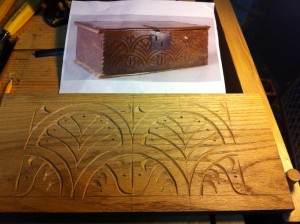
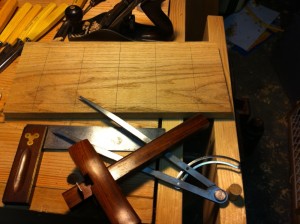




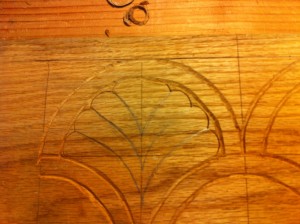
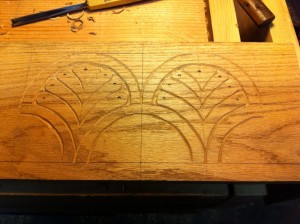
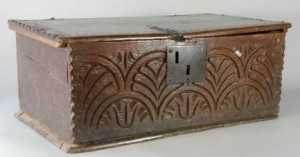
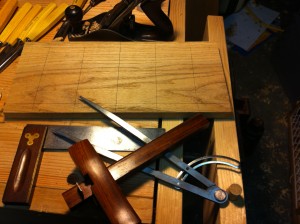
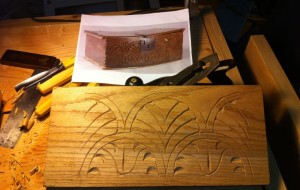


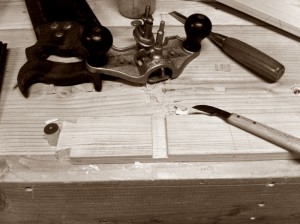

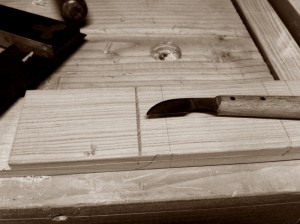

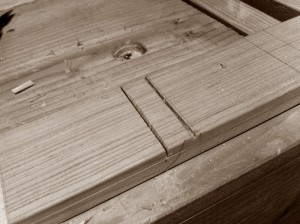
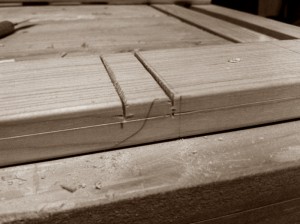
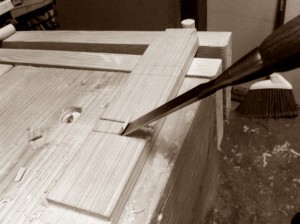
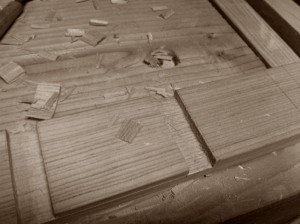
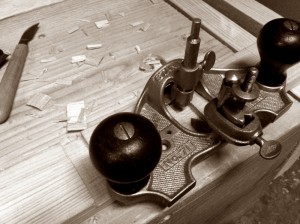
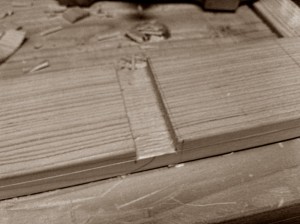





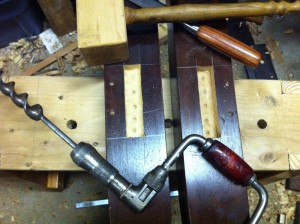


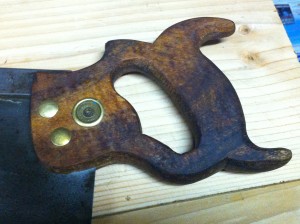

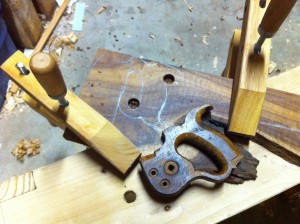

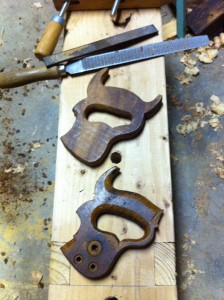

You must be logged in to post a comment.